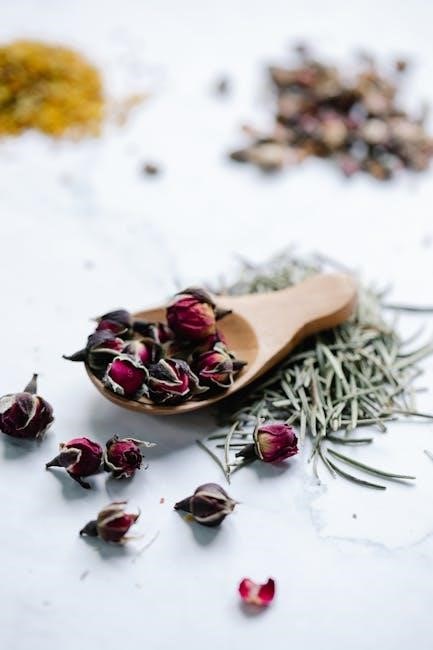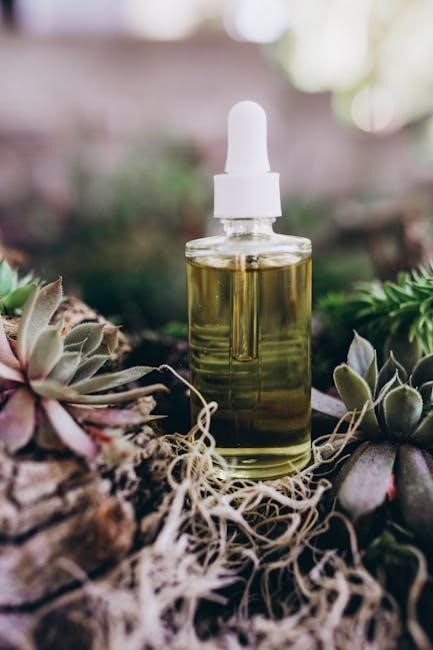The Bible highlights herbs as natural remedies, emphasizing their holistic benefits for physical and spiritual well-being. Frankincense, myrrh, and other plants are prominently featured for their healing properties.
Significance of Herbs in Biblical Times
In biblical times, herbs held profound cultural, spiritual, and medicinal significance. They were integral to daily life, used in rituals, ceremonies, and as natural remedies for various ailments. The Bible frequently references herbs like frankincense, myrrh, and hyssop, highlighting their role in purification, anointing, and healing. These plants were not only valued for their therapeutic properties but also for their symbolic meanings, often representing spiritual purification and divine connection. Herbs were also used in trade, contributing to the economic and cultural exchange of the ancient world. Their versatility and effectiveness made them a cornerstone of biblical healthcare, reflecting a deep understanding of nature’s healing power and a holistic approach to well-being. This tradition underscores the enduring importance of herbs in both spiritual and physical healing practices.
Overview of Herbal Medicine in Scripture
Scripture provides a comprehensive overview of herbal medicine, detailing its use for both physical and spiritual healing. The Bible references various plants like figs, nard, and hyssop, which were utilized for their medicinal properties. Herbal remedies were often prepared as ointments, teas, or infusions, and their applications ranged from treating wounds to purifying rituals. The anointing oils mentioned in Exodus, for instance, were blends of herbs and spices used in sacred ceremonies. Additionally, the prophetic use of herbs in healing is documented, such as Ezekiel’s prescription of a medicinal mixture. This scriptural emphasis on natural remedies highlights a sophisticated understanding of plant-based medicine, blending practical healthcare with spiritual practices. The integration of herbs in both daily life and religious rituals underscores their central role in biblical wellness traditions.

Specific Herbs Mentioned in the Bible
The Bible mentions frankincense, myrrh, aloe vera, hyssop, nard, fig, angelica, and anise hyssop, each valued for their healing properties and use in rituals or medicine.
Frankincense and Myrrh
Frankincense and myrrh are two of the most prominent herbs mentioned in the Bible, renowned for their aromatic and medicinal properties. Frankincense, derived from the Boswellia tree, was used in Temple worship and as a healing balm. Myrrh, extracted from the Commiphora tree, was valued for its anti-inflammatory and antiseptic qualities. Both were used in ancient rituals, anointing oils, and as gifts, as seen in the Magi’s offerings to the baby Jesus. These resins were not only sacred but also played significant roles in traditional medicine, treating wounds and reducing pain. Their use transcends time, with modern applications in aromatherapy and natural remedies, continuing their legacy as powerful healing agents rooted in biblical tradition.
Aloe Vera
Aloe vera, referenced in the Bible, is celebrated for its soothing and medicinal properties. Mentioned in Psalm 45:8 and John 19:39, it was used to treat skin conditions, burns, and wounds. The plant’s gel contains antioxidants and vitamins, making it a natural remedy for inflammation and infections. In ancient times, aloe vera was also used in burial practices, as noted in the anointing of Jesus’ body. Today, it remains a popular ingredient in skincare products and herbal remedies, highlighting its enduring relevance. Its versatility and effectiveness bridge ancient traditions with modern applications, solidifying its place as a timeless healing herb.
Hyssop

Hyssop, a plant deeply rooted in biblical tradition, is celebrated for its cleansing and medicinal properties. It is mentioned in Psalm 51:7, where it symbolizes purification, and in John 19:29, where it is used in the crucifixion narrative. The plant was used in ancient rituals for spiritual cleansing and protection. Hyssop’s antiseptic and anti-inflammatory properties made it effective for treating wounds and respiratory ailments. It was also believed to ward off plagues and diseases. In modern times, hyssop is used in herbal teas, infusions, and remedies for digestive and respiratory issues. Its versatility and historical significance highlight its enduring role in both spiritual and physical healing, bridging ancient practices with contemporary health applications.
Nard
Nard, a fragrant and costly herb, is prominently mentioned in the Bible, particularly in the Song of Solomon 1:12 and John 12:3. Derived from the root of the Nardostachys jatamansi plant, it was highly valued for its aromatic and medicinal properties. In ancient times, Nard was used in perfumes, ointments, and rituals, symbolizing purity and devotion. The herb was also known for its calming effects and anti-inflammatory qualities, making it a sought-after remedy for skin conditions and stress relief. Its rarity and expense underscored its significance in both religious and therapeutic contexts. Today, Nard continues to be studied for its potential health benefits, linking ancient traditions with modern wellness practices.
Fig
The fig tree and its fruit hold significant prominence in the Bible, featured in both Old and New Testament narratives. In 1 Kings 4:25, figs symbolize prosperity and peace under King Solomon’s reign. Jesus also references figs in parables, such as in Matthew 21:18-22, where a barren fig tree represents spiritual fruitlessness. Beyond symbolism, figs were valued for their nutritional and medicinal properties. They were consumed fresh or dried and used to treat various ailments, including boils and skin conditions. In Isaiah 38:21, a fig poultice is applied to King Hezekiah’s boil, highlighting its healing potential. The fig’s versatility and health benefits made it a staple in ancient medicine, bridging cultural and spiritual practices. Its enduring relevance is evident in modern studies exploring its antioxidant and anti-inflammatory properties, aligning ancient wisdom with contemporary wellness.
Angelica
Angelica archangelica, known as the “Holy Ghost Plant,” holds a revered place in biblical and herbal traditions. Its botanical name reflects its historical association with divine protection and healing. Angelica was valued for its versatile medicinal properties, treating ailments from digestive issues to fever. In biblical times, it was believed to ward off plague and evil spirits. The plant’s aromatic roots and stems were used in teas, tinctures, and salves. References in Psalm 45:8 and John 19:39 highlight its spiritual and medicinal significance. Modern studies confirm its anti-inflammatory and antimicrobial benefits, aligning with ancient uses. Angelica’s enduring popularity bridges traditional and contemporary herbal practices, showcasing its timeless healing potential. Its legacy as a natural remedy continues to inspire holistic wellness approaches today.
Anise Hyssop
Anise hyssop, or Agastache foeniculum, is a fragrant herb with biblical roots, mentioned in Matthew 23:23. Its sweet anise-like aroma and flavor made it a popular choice for culinary and medicinal purposes. In ancient times, it was used to aid digestion, relieve coughs, and as a natural remedy for colds. The plant’s leaves and flowers contain essential oils with antibacterial properties, making it effective against infections. Anise hyssop was also used in rituals for purification and protection. Today, it is valued in herbal medicine for its anti-inflammatory and antioxidant benefits. Its versatility and historical significance highlight its importance in both biblical and modern herbal practices, offering a natural solution for various health concerns. Anise hyssop remains a cherished herb, bridging ancient traditions with contemporary wellness.

Botanical and Medicinal Properties
Biblical herbs possess unique botanical traits, with many containing compounds like terpenes and flavonoids. These properties contribute to their anti-inflammatory, antiseptic, and healing effects, validated by modern scientific research.
Botanical Names and Classifications
The Bible mentions several herbs with specific botanical names and classifications. For instance, Aloe vera is classified as Aloe barbadensis, known for its gel-like substance used in healing. Hyssop, or Hyssopus officinalis, is a mint-like herb traditionally used for purification. Frankincense comes from the Boswellia genus, valued for its resin’s anti-inflammatory properties. Myrrh, derived from Commiphora species, has been used for its antiseptic qualities. Nard, or Nardostachys jatamansi, is a fragrant plant mentioned in the New Testament. Each herb has a distinct botanical classification, reflecting its unique properties and uses in both ancient and modern times. These classifications help scientists and herbalists understand their origins and applications in medicine and rituals, bridging the gap between biblical traditions and contemporary practices.
Medicinal Uses in Ancient Times
In ancient times, herbs mentioned in the Bible were widely used for their medicinal properties. Frankincense, derived from the Boswellia tree, was valued for its anti-inflammatory and antiseptic qualities, often used to treat wounds and reduce pain. Myrrh, from the Commiphora plant, was applied to injuries for its antiseptic and antimicrobial effects. Aloe vera was renowned for its soothing gel, used to treat skin conditions like burns and eczema. Hyssop, a mint-like herb, was employed in purification rituals and to alleviate respiratory issues. These herbs were not only used for physical healing but also held spiritual significance, reflecting a holistic approach to health. Their versatility and effectiveness made them integral to ancient medicine, as documented in biblical texts and practices.
Modern Scientific Validation
Modern science has validated the medicinal properties of many herbs mentioned in the Bible. Frankincense, for instance, has been studied for its anti-inflammatory and immune-boosting effects, while aloe vera is widely recognized for its skin-healing properties. Hyssop, noted in ancient texts, has shown antimicrobial activity in contemporary research. Similarly, myrrh has been investigated for its potential anticancer properties. These studies highlight the alignment between traditional biblical remedies and modern pharmacological discoveries, demonstrating the enduring relevance of these plants. By bridging ancient wisdom with scientific evidence, researchers are uncovering new possibilities for natural health treatments inspired by biblical herbs.

Biblical References to Healing Herbs
The Bible references healing herbs like frankincense, myrrh, and aloe vera, noting their use in rituals and remedies. Psalm 45:8 and John 19:39 highlight their significance in ancient practices.
Old Testament References
The Old Testament frequently mentions herbs in the context of healing and religious rituals. For instance, frankincense and myrrh are noted in Exodus for their use in anointing oils and incense. Hyssop, mentioned in Leviticus and Numbers, was used in purification rituals, while aloe vera and nard are referenced in Proverbs and Ecclesiastes for their medicinal properties.
New Testament References
The New Testament also highlights herbs for healing, reflecting their continued significance in Jewish and early Christian practices. John 19:39 mentions aloe vera and myrrh, used to anoint Jesus’s body after crucifixion, underscoring their medicinal and symbolic importance. Similarly, anise hyssop (Agastache foeniculum) is referenced in John 19:29, where it was used to offer Jesus a sponge soaked in vinegar during the crucifixion. These references emphasize the practical and spiritual uses of herbs in healing rituals. While the New Testament does not delve as deeply into herbal remedies as the Old Testament, it reinforces the enduring value of plants in both physical and spiritual healing, aligning with ancient traditions while adapting to emerging theological contexts.
Psalmic and Proverbial Wisdom
The Psalms and Proverbs offer timeless wisdom on the use of herbs for healing, reflecting their significance in ancient Israelite culture. Psalm 45:8 mentions “aloes” alongside cassia, symbolizing purity and healing, while Proverbs emphasizes the importance of plants for health and vitality. Proverbs 4:20-22 encourages attentiveness to health, likening it to guarding one’s life, which aligns with the symbolic use of herbs in biblical healing rituals. These passages highlight the holistic view of wellness, where herbs serve both physical and spiritual purposes. The wisdom literature underscores the enduring value of natural remedies, encouraging reliance on God’s creation for sustenance and healing. This integration of herbal knowledge into sacred texts continues to inspire modern approaches to natural health and spirituality.

Historical and Cultural Practices
Biblical herbs were integral to ancient rituals, trade, and traditional medicine, reflecting deep cultural reverence for their healing and symbolic significance in spiritual and communal life.
Use of Herbs in Rituals and Ceremonies
In biblical times, herbs played a significant role in religious rituals and ceremonies, often symbolizing purification, healing, and spiritual connection; Frankincense and myrrh, for instance, were used in Temple worship, while hyssop was employed in purification rites. The anointing oil, a sacred blend, included herbs like myrrh, cinnamon, and cassia, emphasizing their divine purpose. These plants were not only valued for their aromatic properties but also for their medicinal and symbolic meanings. Rituals often involved burning incense or sprinkling herbs to cleanse and consecrate spaces, reflecting a deep understanding of their holistic benefits. Such practices highlight the integration of herbs in both spiritual and physical healing, showcasing their importance in ancient cultural and religious traditions.
Herbal Remedies in Traditional Medicine
Herbal remedies in traditional medicine, as documented in the Bible, highlight the use of plants for treating ailments. For example, aloe vera was used for skin conditions, and figs were applied to boils. These practices, rooted in ancient wisdom, demonstrate a sophisticated understanding of herbal properties. The Bible also mentions the use of hyssop in purification rituals, showcasing its antiseptic qualities. Traditional medicine relied on natural remedies, often passed down through generations, emphasizing sustainability and holistic health. This approach not only addressed physical health but also aligned with spiritual beliefs, creating a harmonious blend of nature and faith in healing practices. The enduring relevance of these remedies underscores their effectiveness and timeless appeal in promoting well-being. Such methods continue to inspire modern herbalism, bridging ancient traditions with contemporary health practices.

Trade and Commerce of Herbs
The trade and commerce of herbs played a significant role in biblical times, with plants like frankincense and myrrh being highly valued. These herbs, sourced from regions such as Arabia and Ethiopia, were traded extensively along routes like the Incense Road. Their aromatic and medicinal properties made them essential commodities in both religious and healing contexts. The Bible references their use in rituals and ceremonies, highlighting their cultural and economic importance. This trade not only facilitated the spread of herbal remedies but also established a network that connected distant regions, fostering exchange and cultural influence. The commercial value of these plants underscores their relevance in ancient societies, where they were often used in worship, medicine, and daily life, reflecting a deep appreciation for nature’s bounty and its practical applications.

Modern Applications of Biblical Herbs
Biblical herbs like frankincense and myrrh are now used in supplements, essential oils, and aromatherapy, bridging ancient traditions with modern health practices for holistic well-being.
Herbal Supplements and Extracts
Modern herbal supplements and extracts derived from biblical plants offer natural health solutions, blending ancient wisdom with contemporary science. These products leverage the medicinal properties of plants like frankincense, myrrh, and aloe vera, which are renowned for their anti-inflammatory, antiseptic, and soothing effects. Many supplements are formulated to address specific health concerns, such as digestive issues, skin ailments, or immune support. Extracts are often concentrated forms of these herbs, making them potent additions to daily wellness routines. The convenience of these products allows individuals to incorporate biblical herbs into their lives seamlessly, whether through capsules, tinctures, or topical applications.
- Frankincense and myrrh are commonly used in supplements for their anti-inflammatory properties.
- Aloe vera extracts are popular for skin health and digestion.
- Hyssop and nard are utilized in natural remedies for respiratory and stress-related conditions.
Essential Oils and Aromatherapy
Biblical herbs have found a modern resurgence in essential oils and aromatherapy, offering therapeutic benefits rooted in ancient traditions. Frankincense, myrrh, and other plants mentioned in Scripture are distilled into potent oils, valued for their aromatic and healing properties. These oils are used to promote relaxation, reduce stress, and enhance physical well-being, aligning with their historical use in rituals and healing practices. Aromatherapy harnesses the scent of these oils to create calming environments and address various health concerns, such as inflammation, skin issues, and respiratory problems. The timeless appeal of these oils lies in their natural, holistic approach to wellness, bridging the gap between ancient biblical wisdom and contemporary health practices;
- Frankincense oil is known for its calming and anti-inflammatory effects.
- Myrrh oil is used for skin health and emotional balance.
- Hyssop and nard oils are utilized for respiratory and spiritual well-being.

Natural Healing in Contemporary Practices
Modern natural healing practices draw inspiration from biblical herbs, integrating their timeless benefits into contemporary wellness routines. Products like Wisdom Nutrition’s herbal extracts blend ancient plants for holistic health, while digital guides revive lost remedies. These herbs are now used in supplements, skincare, and holistic medicine, offering natural alternatives. Frankincense and myrrh are prized for their anti-inflammatory and antimicrobial properties, while hyssop and aloe vera are valued for their soothing effects. This resurgence reflects a growing interest in natural, faith-based healing, bridging ancient traditions with today’s health needs.
- Frankincense and myrrh are used in skincare and pain relief.
- Aloe vera and hyssop are popular for their soothing properties.
- Biblical herbs are increasingly found in modern supplements.
Biblical herbs, with their timeless healing properties, continue to inspire modern wellness practices, bridging ancient traditions and contemporary health needs sustainably.
Timeless Wisdom of Biblical Herbs
Biblical herbs embody ancient wisdom, offering natural remedies that have stood the test of time. From frankincense to myrrh, these plants were valued for their healing properties and spiritual significance. Their use in rituals, ceremonies, and medicinal practices highlights a deep understanding of nature’s bounty. The Bible’s emphasis on herbs reflects a holistic approach to health, blending physical and spiritual well-being. Today, these plants continue to inspire modern herbal medicine, confirming their enduring relevance. The timeless wisdom of biblical herbs lies in their ability to connect humanity with the natural world, providing sustainable and harmonious solutions for health and wellness.
Future of Herbal Medicine

The future of herbal medicine is poised for growth, blending ancient biblical wisdom with modern scientific advancements. Biblical herbs like frankincense, myrrh, and aloe vera are gaining attention for their potential in addressing contemporary health challenges. Research into their medicinal properties is validating their historical use, opening doors to new pharmaceutical applications. As natural remedies gain popularity, the integration of biblical herbs into supplements, essential oils, and holistic practices is expected to rise. This resurgence highlights the enduring relevance of these plants, bridging the gap between traditional knowledge and modern healthcare. By combining historical insights with scientific innovation, the future of herbal medicine promises sustainable, effective, and naturally derived solutions for global well-being.